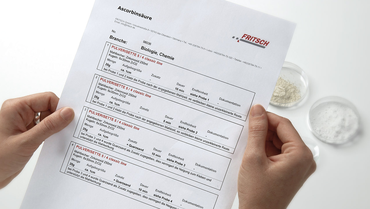Назад к обзору
Purple Moor-Grass - Comminution of Molinia Caerulea
Molinia are a genus of the family of sweet grasses
Especially in northern Germany occurs the Purple Moor- Grass (Molinia Caerulea). The popular German name – Pfeifengras (pipe grass) - derives from the use of the hard stalks as pipe cleaners. Interesting for research are the absolute contents and the ratios of carbon and nitrogen in the plant material. For the determination of these values mostly carbon and nitrogen analyzers are utilized.
Test with the Variable Speed Rotor Mill
For milling purposes, dried and pre-crushed grass was supplied by the customer. Clearly visible are the name-giving hard blades of grass. The requirement of the task was that the material shall be smaller than 0.2 mm. The prospective customer selected the Variable Speed Rotor Mill PULVERISETTE 14 classic line as the instrument for the job. Complying with this demand, the mill was equipped with a 0.2 mm sieve. The result is not satisfactory. Several blades of grass remained intact in their full length.
Grinding with a 2 mm sieve
Optimized grinding process the with impact bar
For the optimization of the comminution, a so called impact bar is available for this mill. With this, long, fibrous particles can be broken down well. The next test was therefore performed with the impact bar and a 1 mm sieve. With it, optically, a pretty good result was achieved here. Now the hope existed, that in a second step, by utilizing a finer sieve the desired end fineness could be achieved.
Is the impact bar with a 0.08 mm sieve inserted, oblong particles are still clearly visible though. For a initial sample weight of 300 mg, for the classic analysis, this fineness is sufficient. The right photo shows 300 mg.
Comminution Planetary Micro Mill PULVERISETTE 7 classic line
The carbon nitrogen analyzers only work with 20 mg net weight though. This immediately raises the question for an even finer prepared sample. The solution was found with the Planetary Micro Mill PULVERISETTE 7 classic line. For tough, elastic materials for example hair, we mostly recommend to use sintered corundum bowls and balls. For the described application, bowls and balls made of hardened steel were proven to be better though.
Test with grinding set made of sintered corundum
For the first test, the base sample (not additionally comminuted), was added into the sintered corundum bowl and milled for 20 minutes. Afterwards the grass had been ground down to a homogenous fine powder. Since the sample amounts which are to be added into the bowl are relatively small, a pre- comminution of the samples with the Variable Rotor Speed Mill and impact bar and a 1 mm sieve are in regards to the representativeness recommended.
Comminution with a steel grinding set
In additional tests with the Planetary Micro Mill PULVERISETTE 7 classic line, pre-crushed material was added and the steel grinding set used. After 10 minutes the grass was ground into powder like shown in the photo here: with the Planetary Ball Mill PULVERISETTE 7 classic line equipped with a steel grinding set. The grass is now a powder. Are 20 mg of this sample weighted in, it safely can be assumed, that a representative sample is added to the measuring instrument.
-
Download the FRITSCH-report as PDF file
-
Detailed grinding reports
Назад к обзору













